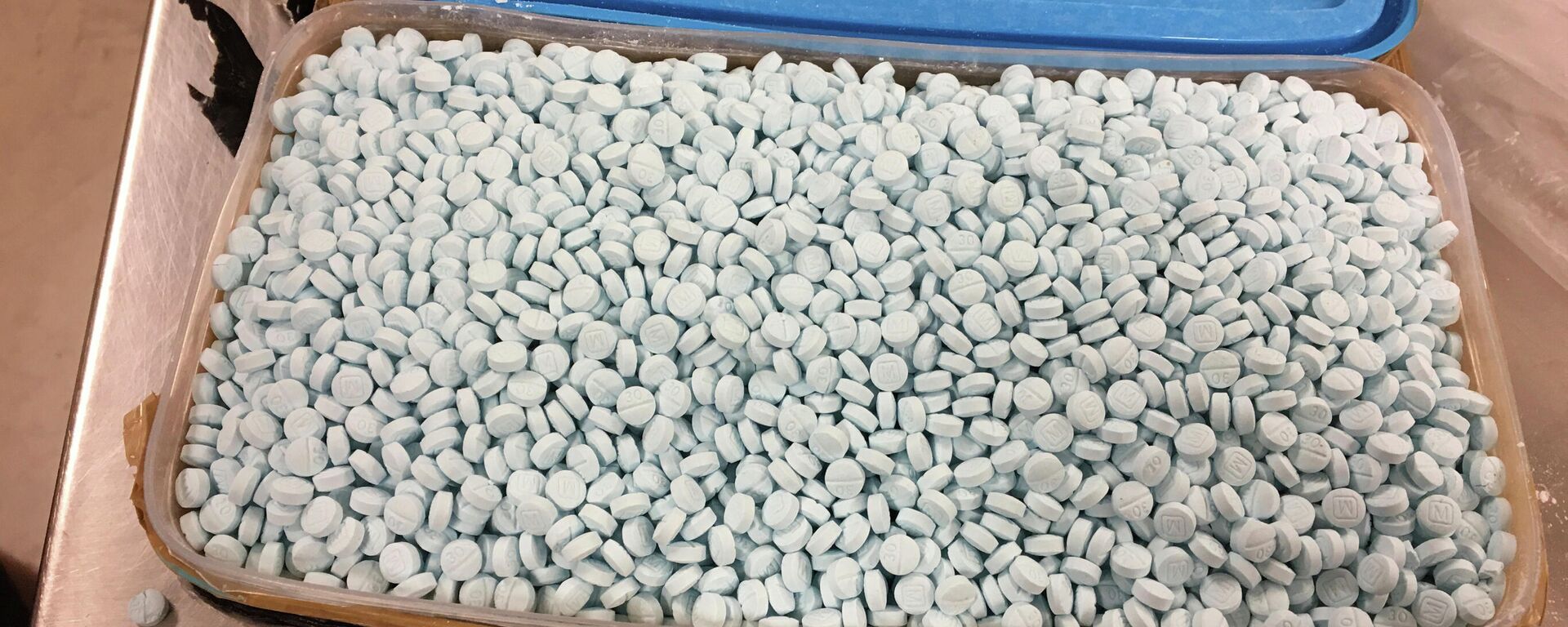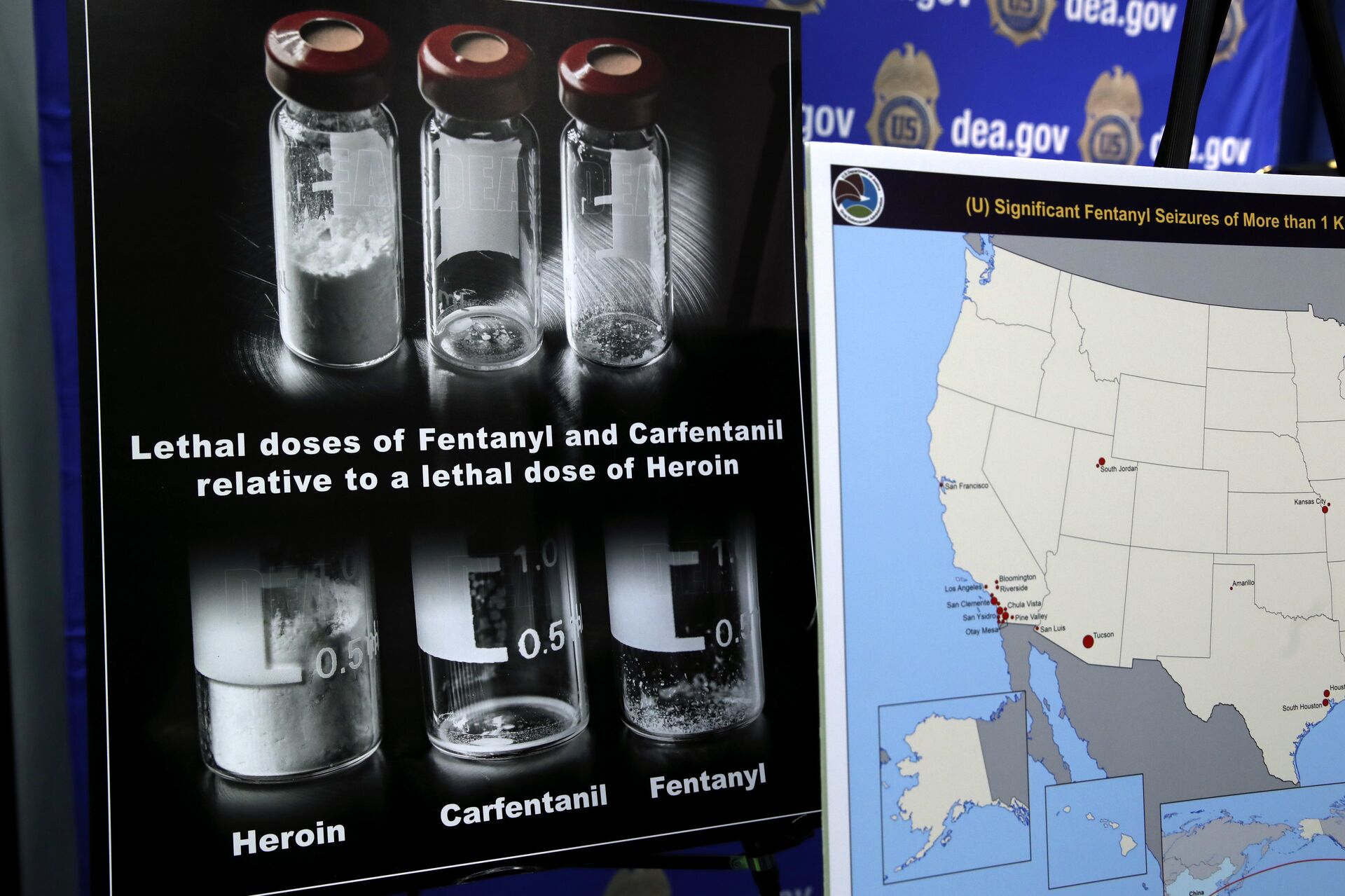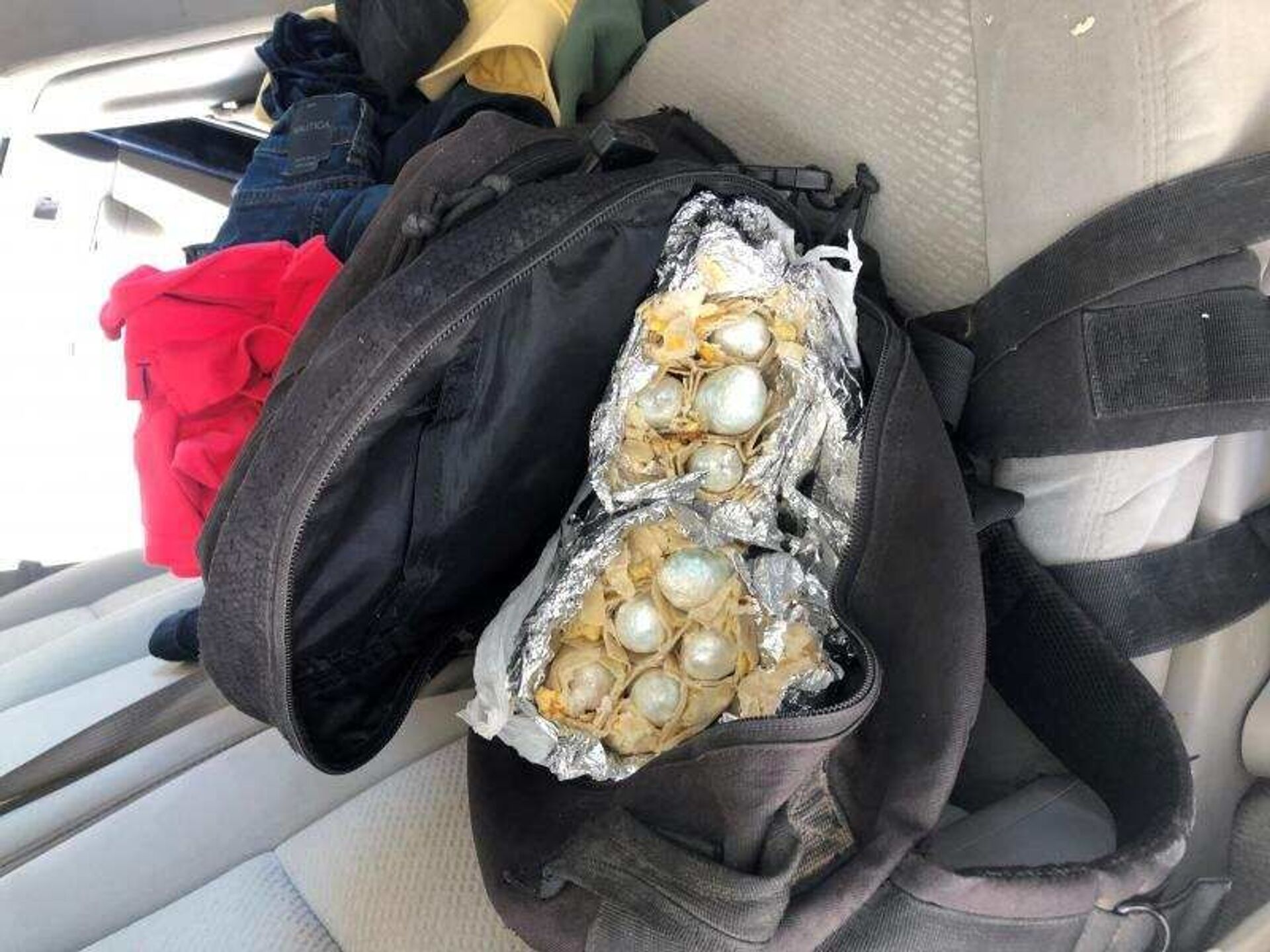https://sputnikglobe.com/20221222/whats-fuelling-opioid-overdose-crisis-in-us-1105693306.html
What’s Fuelling Opioid Overdose Crisis in US?
What’s Fuelling Opioid Overdose Crisis in US?
Sputnik International
Synthetically produced drugs have been the cause of more than seventy thousand fatal drug overdoses across the US in 2021. This is a significant surge as compared to slightly under fifty eight thousand such deaths registered a year earlier. The opioid fentanyl, DEA data showed, was to blame for a greater part of the opioid overdose crisis in the US.
2022-12-22T15:24+0000
2022-12-22T15:24+0000
2022-12-22T15:24+0000
us
fentanyl
opioid crisis
opioids
drug overdose
synthetic drugs
drug enforcement agency (dea)
sputnik explains
https://cdn1.img.sputnikglobe.com/img/107660/20/1076602086_84:0:3723:2047_1920x0_80_0_0_81df691e983dd40ac5256da3e25ed2fa.jpg
Synthetic opioids like fentanyl - a super-potent, but also toxic pain killer - are resulting in more fatalities in the Unites States than deadly car crashes or shooting incidents, the Centers for Disease Control and Prevention (CDC) stated. Over 107,000 Americans met an untimely death in 2021 as a result of overdosing on such non-plant-based drugs, with two-thirds of those victims attributed to fentanyl. How did a painkiller morph into the “single deadliest drug threat” America has ever faced, as stated by the Drug Enforcement Administration (DEA)? Let's take a look at some key things to know about fentanyl.What is the Deadly Opioid Fentanyl?Fentanyl, whose medical formula is C22H28N2O, is a pain killer that one can only purchase with a doctor's prescription. Classified as a Schedule II controlled substance in the US, the agonist of μ-opioid receptors is the go-to measure when other pain medicines have failed to alleviate severe pain, such as after surgery, or for cancer patients. Sometimes also spelled fentanil, the pain killer is available in diverse formulations and strengths. Intravenously, fentanyl is also used as an anesthetic during invasive medical treatments.It was back in 1959 that a Belgian physician by the name of Paul Janssen, in collaboration with fellow-researchers, synthesized fentanyl at his pharmaceutical company, Janssen Pharmaceutica. By the 1990s, the aforementioned company introduced the fentanyl skin patch.What Does Fentanyl Look Like?Fentanyl can come in diverse forms and shapes: adhesive skin patches, throat drops, and pills. Fentanyl may also be found as powder, white in color, or a colorless liquid. However, when other drugs enter into the fray, mixed in deliberately for the purpose of creating recreational opioids, fentanyl can appear in the form of pills of different hues, such as green, blue, and others.How Does Fentanyl Work?What happens when one takes fentanyl is that it cuts in on how nerves signal pain between the brain and the body. The medication affects the so-called opioid receptors in the central nervous system. Thus, pain is mitigated. But there are other sensations too, as by blocking pain receptors in the brain, it boosts the euphoria and happiness-inducing chemical dopamine.But there is also a down side, as fentanyl affects all people in a different manner. Thus, for some the analgesic can trigger everything from confusion and sleepiness to dizzy spells, nausea, and vomiting.Is Fentanyl Stronger Than Morphine?Yes, the opioid packs a potency up to 100 times that of morphine. It is also up to 50 times stronger than heroin, its plant-derived alternative.Heroin is made using morphine, which is a natural substance its manufacturers derive from a poppy plant seed pod, with the paste then used to create a powder. How Much Fentanyl Can Kill?While there are many diverse factors that need to be taken into account, such as body weight, height, individual tolerance to opioids, and whether an individual has used such medication before, approximately one two milligram (mg) dose of fentanyl can be lethal for an adult.As to how fast that fatal outcome might happen, US health officials say death could come in two minutes, as a rule due to respiratory failure.Why is Fentanyl Deadlier Than Heroin?Fentanyl is much more toxic and deadly than heroin precisely due to its strength. If one were to take a look at two pictures showing lethal doses of fentanyl and heroin, one would easily see the marked difference. Thus, a lethal dose of heroin would be equivalent to about 30 milligrams, while a three-milligram dose of fentanyl is capable of claiming the life of an average-sized adult male.To make matters worse, many counterfeit pills that are laced with fentanyl contain more than twice the lethal dose.Where is Fentanyl Made?The pharmaceutical ingredients for production of fentanyl are predominantly made in India and China. Originally, China exported finished fentanyl to the US. However, after Beijing ensured that the fentanyl-type class of drugs fell under a strict new controlled regulatory schedule in May 2019, its illicit traders switched to funneling precursor chemicals to Mexico's powerful drug cartels, particularly the Sinaloa Cartel and the Jalisco New Generation Cartel (CJNG), according to the DEA.The opioid itself is typically "cut for consumption" closer to its customer base.Why is Fentanyl so Prevalent?Fentanyl is prevalent because it is a synthetic drug, unlike raw-ingredient-based heroin or cocaine. The latter two need poppy or coca for their manufacture. Fentanyl, however, can be created in a lab with a compound called NPP (N-phenethyl-4-piperidone) and a combination of other chemicals. Furthermore, fentanyl is cheap to make. So, its potency and manufacturing simplicity lend a hand in rendering it easier for suppliers to dodge law enforcement crackdowns.Why are Drugs Laced With Fentanyl?Capitalizing on fentanyl's extreme potency, illicit drug-makers add the lab-made opioid to pills to make them stronger and more addictive. Fentanyl is added to heroin to increase its potency effect. For example, take carfentanil. This is a fentanyl "analog." It is manufactured by having one chemical group substituted for another, with the result being an opioid that is roughly 100 times more potent. Since about 1979, drug dealers in the US have been using such fentanyl analogs in their illicit drug supplies. Accordingly, the first overdoses began to be registered in individual cities across the country.What is Fuelling Opioid Overdose Crisis in US?Besides being cheaper, easier to make, and packing a potent punch, as stated above, fentanyl began increasingly replacing heroin as drug dealers and traffickers can expect to line their pockets easier and faster.Unlike heroin, which requires poppy fields to grow, and the plants to subsequently be harvested, with the ensuing process of refining the poppy paste into powder and shipped north, fentanyl or its precursor ingredients can be shipped and quickly put to use in clandestine labs. Less effort required - many, many more doses manufactured.Furthermore, as addictive prescription painkillers got more difficult to obtain, the demand for fentanyl grew. At this point, health officials clarify that fentanyl started taking a particular toll on longtime urban users who were not fully aware how much more potent it was than heroin. Hense, growing overdoses. The COVID-19 pandemic also played a deadly role here. It restricted cross-national traffic, with smugglers increasingly challenged as to how to move their more bulky illegal drug cargoes. Whether in powder or pill form, fentanyl is much easier to transport in small quantities. Traffic by mail has become increasingly used in such cases.The amount of the synthetic opioid seized by American drug squads in 2022 alone would be enough “to kill everyone in the United States,” the US Drug Enforcement Administration (DEA) stated on December 20 in a news release. It added that over 379 million potentially fatal illegal doses of the prescription painkiller have been confiscated so far. How Can You Prevent a Fatal Fentanyl Overdose?According to health guidance, it is best to familiarize oneself with the signs of excessive fentanyl use. These may be: slow breathing, very pale skin color, a blue tinge to the lips or fingernails, abnormal drowsiness, very loud snoring, and general difficulty waking up a suspected overdose victim. The commonly resorted-to antidote is naloxone, although health experts say it is not completely effective.
https://sputnikglobe.com/20221215/dramatic-footage-shows-florida-officer-accidentally-overdose-on-fentanyl-during-traffic-stop-1105472395.html
https://sputnikglobe.com/20221221/us-drug-squads-seize-enough-illegal-fentanyl-in-2022-to-kill-everyone-in-united-states-1105664888.html
Sputnik International
feedback@sputniknews.com
+74956456601
MIA „Rossiya Segodnya“
2022
News
en_EN
Sputnik International
feedback@sputniknews.com
+74956456601
MIA „Rossiya Segodnya“
Sputnik International
feedback@sputniknews.com
+74956456601
MIA „Rossiya Segodnya“
what is fentanyl, synthetically produced drugs, opioid overdose, what is fuelling opioid overdose crisis in us, is fentanyl stronger than morphine, how does fentanyl make you feel, is fentanyl cheap, where is fentanyl made,
what is fentanyl, synthetically produced drugs, opioid overdose, what is fuelling opioid overdose crisis in us, is fentanyl stronger than morphine, how does fentanyl make you feel, is fentanyl cheap, where is fentanyl made,
What’s Fuelling Opioid Overdose Crisis in US?
Synthetically produced drugs were the cause of more than 70,000 fatal drug overdoses across the US in 2021. This is a significant surge as compared to slightly under 58,000 such deaths registered a year earlier. The synthetic opioid fentanyl, DEA data showed, was to blame for a greater part of the fatal overdose incidents.
Synthetic opioids like fentanyl - a super-potent, but also toxic pain killer - are
resulting in more fatalities in the Unites States than deadly car crashes or shooting incidents, the Centers for Disease Control and Prevention (CDC) stated. Over 107,000 Americans met an untimely death in 2021 as a result of overdosing on such non-plant-based drugs, with two-thirds of those victims attributed to fentanyl.
How did
a painkiller morph into the “single deadliest drug threat” America has ever faced, as stated by the Drug Enforcement Administration (DEA)? Let's take a look at some key things to know about fentanyl.
What is the Deadly Opioid Fentanyl?
Fentanyl, whose medical formula is C22H28N2O, is a pain killer that one can only purchase with a doctor's prescription. Classified as a Schedule II controlled substance in the US, the agonist of μ-opioid receptors is the go-to measure when other pain medicines have failed to alleviate severe pain, such as after surgery, or for cancer patients. Sometimes also spelled fentanil, the pain killer is available in diverse formulations and strengths. Intravenously, fentanyl is also used as an anesthetic during invasive medical treatments.
It was back in 1959 that a Belgian physician by the name of Paul Janssen, in collaboration with fellow-researchers, synthesized fentanyl at his pharmaceutical company, Janssen Pharmaceutica. By the 1990s, the aforementioned company introduced the fentanyl skin patch.
What Does Fentanyl Look Like?
Fentanyl can come in diverse forms and shapes: adhesive skin patches, throat drops, and pills. Fentanyl may also be found as powder, white in color, or a colorless liquid. However, when other drugs enter into the fray, mixed in deliberately for the purpose of creating recreational opioids, fentanyl can appear in the form of pills of different hues, such as green, blue, and others.
What happens when one takes fentanyl is that it cuts in on how nerves signal pain between the brain and the body. The medication affects the so-called opioid receptors in the central nervous system. Thus, pain is mitigated. But there are other sensations too, as by blocking pain receptors in the brain, it boosts the euphoria and happiness-inducing chemical dopamine.
But there is also a down side, as fentanyl affects all people in a different manner. Thus, for some the analgesic can trigger everything from confusion and sleepiness to dizzy spells, nausea, and vomiting.
Is Fentanyl Stronger Than Morphine?
Yes, the opioid packs a potency up to 100 times that of morphine. It is also up to 50 times stronger than heroin, its plant-derived alternative.
Heroin is made using morphine, which is a natural substance its manufacturers derive from a poppy plant seed pod, with the paste then used to create a powder.
How Much Fentanyl Can Kill?
While there are many diverse factors that need to be taken into account, such as body weight, height, individual tolerance to opioids, and whether an individual has used such medication before, approximately one two milligram (mg) dose of fentanyl can be lethal for an adult.
As to how fast that fatal outcome might happen, US health officials say death could come in two minutes, as a rule due to respiratory failure.

15 December 2022, 04:17 GMT
Why is Fentanyl Deadlier Than Heroin?
Fentanyl is much more toxic and deadly than heroin precisely due to its strength. If one were to take a look at two pictures showing lethal doses of fentanyl and heroin, one would easily see the marked difference. Thus, a lethal dose of heroin would be equivalent to about 30 milligrams, while a three-milligram dose of fentanyl is capable of claiming the life of an average-sized adult male.
To make matters worse, many counterfeit pills that are laced with fentanyl contain more than twice the lethal dose.
The pharmaceutical ingredients for production of fentanyl are predominantly made in India and China. Originally, China exported finished fentanyl to the US. However, after Beijing ensured that the fentanyl-type class of drugs fell under a strict new controlled regulatory schedule in May 2019, its illicit traders switched to funneling precursor chemicals to Mexico's powerful drug cartels, particularly the Sinaloa Cartel and the Jalisco New Generation Cartel (CJNG), according to the DEA.
The opioid itself is typically "cut for consumption" closer to its customer base.
Why is Fentanyl so Prevalent?
Fentanyl is prevalent because it is a synthetic drug, unlike raw-ingredient-based heroin or cocaine. The latter two need poppy or coca for their manufacture. Fentanyl, however, can be created in a lab with a compound called NPP (N-phenethyl-4-piperidone) and a combination of other chemicals. Furthermore, fentanyl is cheap to make.
So, its potency and manufacturing simplicity lend a hand in rendering it easier for suppliers to dodge law enforcement crackdowns.
Why are Drugs Laced With Fentanyl?
Capitalizing on fentanyl's extreme potency, illicit drug-makers add the lab-made opioid to pills to make them stronger and more addictive. Fentanyl is added to heroin to increase its potency effect. For example, take carfentanil. This is a fentanyl "analog." It is manufactured by having one chemical group substituted for another, with the result being an opioid that is roughly 100 times more potent. Since about 1979, drug dealers in the US have been using such fentanyl analogs in their illicit drug supplies. Accordingly, the first overdoses began to be registered in individual cities across the country.
What is Fuelling Opioid Overdose Crisis in US?
Besides being cheaper, easier to make, and packing a potent punch, as stated above, fentanyl began increasingly replacing heroin as drug dealers and traffickers can expect to line their pockets easier and faster.
Unlike heroin, which requires poppy fields to grow, and the plants to subsequently be harvested, with the ensuing process of refining the poppy paste into powder and shipped north, fentanyl or its precursor ingredients can be shipped and quickly put to use in clandestine labs. Less effort required - many, many more doses manufactured.
Furthermore, as addictive prescription painkillers got more difficult to obtain, the demand for fentanyl grew. At this point, health officials clarify that fentanyl started taking a particular toll on longtime urban users who were not fully aware how much more potent it was than heroin. Hense, growing overdoses. The COVID-19 pandemic also played a deadly role here. It restricted cross-national traffic, with smugglers increasingly challenged as to how to move their more bulky illegal drug cargoes. Whether in powder or pill form, fentanyl is much easier to transport in small quantities. Traffic by mail has become increasingly used in such cases.
The amount of the synthetic opioid seized by American drug squads in 2022 alone would be enough “to kill everyone in the United States,” the US Drug Enforcement Administration (DEA) stated on December 20 in a news release. It added that over 379 million potentially fatal illegal doses of the prescription painkiller have been confiscated so far.
How Can You Prevent a Fatal Fentanyl Overdose?
According to health guidance, it is best to familiarize oneself with the signs of excessive fentanyl use. These may be: slow breathing, very pale skin color, a blue tinge to the lips or fingernails, abnormal drowsiness, very loud snoring, and general difficulty waking up a suspected overdose victim. The commonly resorted-to antidote is naloxone, although health experts say it is not completely effective.

21 December 2022, 13:02 GMT






